Harvey Smith talks chaos, open worlds, and the differences between Dishonored 2 and Prey
The co-creative director on Corvo, Kaldwin, combat, and context.
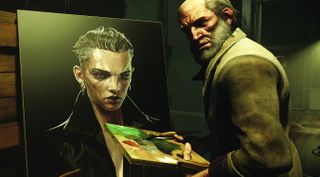
This article was originally published in PC Gamer issue 297. For more quality articles about all things PC gaming, you can subscribe now in the UK and the US.
Harvey Smith played a key role on two of PC’s most celebrated games ever, Deus Ex and Dishonored. On November 11, after a four-year wait, we’re finally getting a sequel to the latter, set in an entirely new part of Dishonored’s universe and featuring two player characters this time: Corvo and Emily. Here, PC Gamer catches up with co-creative director Harvey Smith at QuakeCon in Dallas.

Harvey Smith has worked in the games industry for over 20 years. His résumé boasts the likes of Ultima 8, System Shock, Deus Ex and, of course, the Dishonored series.
PC Gamer: Moving from Dishonored 1 to Dishonored 2, what did you want to do more of or explore more deeply when you went into this game?
Harvey Smith: At the end of Dishonored 1, I wasn’t even that motivated about Dishonored 2, I didn’t have a hook yet because it was a long project. We had this spark of an idea... what if we moved it forward fifteen years and played as Emily? And so that was really the beginning of the super-excitement. However, with the whole formula, I’ve always been in love with first-person. It’s very immersive, very atmospheric, you play at your own pace and no other players are rushing around you. You can sit behind that chair and peer around the corner and eavesdrop on those characters for a while.
So we knew that what would be coming back is first-person melee combat, stealth, player pacing, the atmosphere, the world and the lore—we loved that, the Empire of the Isles is an interesting setting—assassination missions, multiple pathways... but then there were other things that we wanted to do better. So that was a guiding principle, a bigger and better Dishonored. And we did that in many ways—like, all the powers are back for Corvo, but they all have trees of upgrades beneath them. So for rat swarm you can not only do a rat swarm, but you can make two swarms now, or you can make a larger swarm or you can make one that follows you, or you can mix all those things. You can be that guy now who summons two swarms of rats in two different groups that are larger than normal—twice the rats—and then you take off after that and all the rats follow you like the Pied Piper.
PCG: That’s a good example of a bigger, better Dishonored—it conveniently works with the fact that it’s been fifteen years and he’s probably learned a few new tricks and he’s got more experience.
HS: Yeah, I guess you could see it that way. But another example of the bigger and better is the combat moves have expanded so you have more moves in combat —the missions have this big epic theme in now, so the Dust District has two assassination targets, random dust storms that affect visibility in stealth, the Clockwork Mansion has... you can reconfigure all the rooms with levers so that the floor, walls and ceiling change. And we’ve shown the Crack in the Slab mission where the house exists in two different time periods and you can seamlessly move back and forth between the ruined present and the pristine past when it was posh.
PC Gamer Newsletter
Sign up to get the best content of the week, and great gaming deals, as picked by the editors.
There were many ways that we tried to make a bigger and better Dishonored, but then there were about five areas where the fans gave us feedback. Even the people that really loved the game, they would like something better in that area.
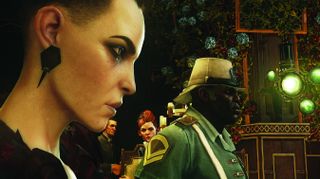
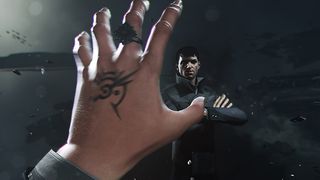
Dishonored 2 is due November 11—make sure your system requirements are up to speed before then.
PCG: That was going to be my next question. Players did complain about the endings available in Dishonored. What are you trying to do there?
HS: The endgames were a bit binary and so this time we have a very procedural endgame system where there are many different permutations in the endgames, and for each of those there’s a high and low chaos version so it’s... a hybrid now based on the branching decisions you made along the way and how many people you killed in the end.
People also said that it was a little simplistic how "Just kill less than 20% of the people and you’re low chaos". So we decided... we loved all the things we did well and that the fans liked and we doubled down on those, but there were four top things that we wanted to fix, and that is a good example of one of them. This time we have characters that are like, in the world, and we, procedurally at the beginning of the game, allocate them a kind of morality. So there’s a murderous guy, a guilty guy and a sympathetic guy and if you use the Heart on them, it might whisper that "This guy works some extra shifts so he can feed the family down the road because their father died". He is worth more points if you kill him towards high chaos. You point it at someone else and it might say "She murders the elderly people in her apartment building and takes their retirement money"—she is a ‘bad’ character so she is worth less—she destabilises the world less.
PCG: So maybe killing some street thugs or something would be not as dangerous as killing other characters who play a more significant role in the world?
HS: Yes. We still take that stance that killing a bunch of people destabilises society, sure, but less. Players asked for more non-lethal options—so now in addition to the drop assassination, you can hit a different button as you fall and knock them out. And in combat, as you perfectly block with the timing, you throw them off balance and instead of just killing them, you can also chop them in the throat, spin them around and choke them out.
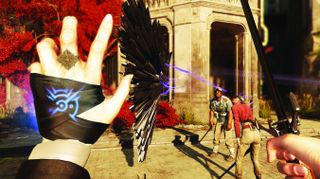
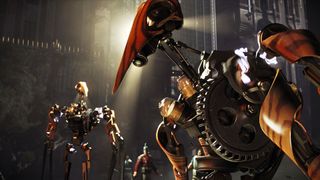
Shaun spent three hours exploring Dishonored 2's Clockwork Mansion—a level he said "echoes, but in some ways surpasses, the original's design."
PCG: So basically you’re giving us more systems to play with this time around?
HS: And really targeting those four or five things that we thought we could do better, right?
PCG: The mission structure where there’s a home base and then you go out into very specific self-contained open-world settings... that’s coming back, yes?
HS: That’s a good way to see it, we see them as mini-open worlds, and there are strengths and weakness to that. Prey takes a different approach: they’re basically one big seamless mission which is really cool—you feel the simulation there. So we lose that, but what we gain is, each time the mini-open world can be totally different, like the Clockwork Mansion one time and the Dust District another time.
PCG: Are you at all worried that Dishonored 2 and Prey may be too similar?
HS: We definitely think there’s enough room for your Deus Exes and your Stalkers and your Far Cry 2s and your Preys and your Dishonoreds and the world of BioShocks. I think once you play Prey you’ll see that it’s a different kind of alt-history.
Most Popular


